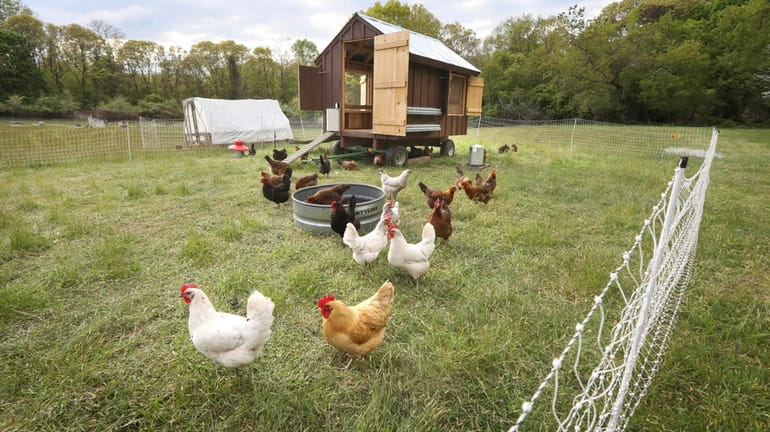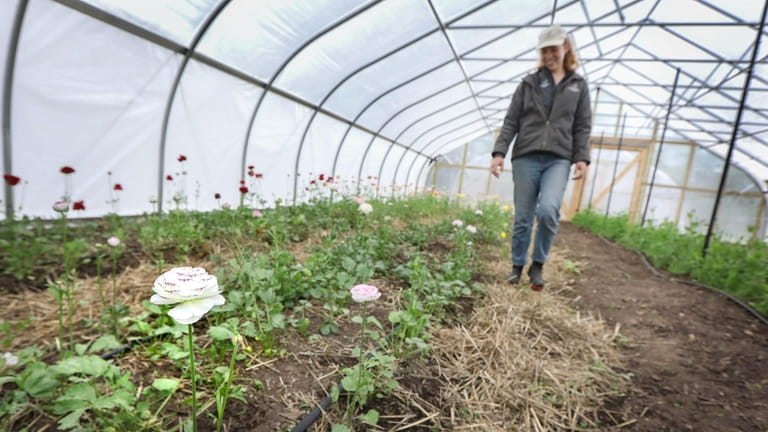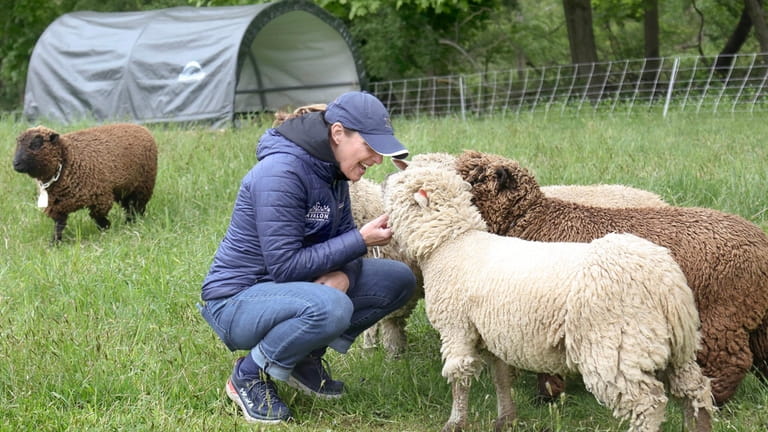Birdsfoot, among the newest farms on Long Island, wins site plan approval from Head of the Harbor

Off Route 25A in Head of the Harbor Village, a field of sorghum and legumes is growing, and one of clover and rye. A greenhouse crop of flowers is ready for cutting. Chickens, babydoll lambs and Spanish goats are grazing.
This is Birdsfoot, among the newest farms on Long Island, whose founders say their style of farming — called regenerative agriculture — will bring crops to market even as it heals the land. Last month, village officials approved a site plan with a barn, accessory buildings and parking; in February, they approved a special permit for agricultural use of the site.
"It might feel counterintuitive that we can farm it into a better environment, but I think it's true that we can use farming to help that ecological diversity," said Annalee Holmdahl, 28, who manages Birdsfoot's agricultural operations and lives on-site.
Starting a farm in 21st-century suburbia takes land, labor and capital; it helps to have the backing of a billionaire.
Birdsfoot has all the above.
A project of the Stony-Brook based Avalon Nature Preserve, Birdsfoot grew out of the nonprofit's 2018 $7.7 million purchase of 46 acres of disused farmland near its holdings on the village's north side. Avalon was formed by hedge funder Jim Simons to honor his son, Paul, who died in 1996.

Annalee Holmdahl, who manages Birdsfoot's agricultural operations, walks through one of the greenhouses at the farm. Credit: Newsday/John Paraskevas
Avalon director Katharine Griffiths, who worked on cattle and poultry farms growing up in rural Canada, hired Holmdahl, a former Hudson Valley farmer, and Ryan Lertora, 34, former manager of Jamesport Farmstead, an organic farm, to oversee livestock.
Birdsfoot has three employees and will add seasonal help this summer. Operating expenses in 2022, its first year, were $130,000. The farm cleared a fraction of that sum by selling eggs and flowers at its farm stand last year, though sales may increase as it brings new products like wool to market.

Avalon director Katharine Griffiths greets baby doll sheep that are being raised at Birdsfoot Farm. Credit: Newsday/John Paraskevas
Regenerative strategy
For Griffiths, choices about what plants and animals to raise are not just commercial but go to the heart of the farm's regenerative strategy — to “create a healthier habitat, not only for the livestock, but any grain production we do, any vegetables we grow, and for the natural environment.”
The U.S. Department of Agriculture defines regenerative agriculture as a set of practices including use of cover crops, biodiversity, compost and minimal soil disruption to improve soil health and productivity.
Many of these overlap with organic practices, and Birdsfoot farmers use no pesticides, relying on cover crops, insect-repelling plants and simply picking the bugs by hand. They use no conventional fertilizer, relying on manure, compost and fish and kelp meal. To manage erosion and nitrogen, a critical nutrient, they do not till their land, instead they use a seed drill borrowed from Cornell Cooperative Extension during planting.
'Farmland in a residential area'
On Long Island, with about 600 farms and 30,000 acres under cultivation — mostly on Suffolk County's East End — Birdsfoot is unusual, and not just because of its farming style, said Robert Carpenter, director of the Long Island Farm Bureau, a trade group.
“It’s very rare that a new farm is coming back into existence and producing crops,” he said. “The cost of land, what it takes to start farming again, the ability to regenerate soils, the cost of doing business — it’s not easy to be a farmer, so this is a unique opportunity to actually create farmland in a residential area.”
Edged by forest and towering hedgerows, this land was cultivated for much of the last century, when it was known as the Perry Farm, but when Birdsfoot farmers took over they found soil so compacted that roots had trouble penetrating. It didn’t have enough organic material and had become too acid to efficiently grow many crops.
Holmdahl's aim is to "use what's here to our advantage." The stand of hardy birch trees that's taken over a former field will provide timber and shade for livestock. Her legumes are restoring soil health by converting nitrogen into fertilizer, a process known as nitrogen fixation. Lertora’s goats have been set upon invasive interlopers like the mile-a-minute vines in the hedgerows.
The sheep are also doing their part, triggering an evolved response from grass under grazing stress that sends its roots deep into the soil.
“It’s storing more carbon, it’s reducing compaction in the soil, it’s bringing oxygen in as well,” Lertora said.
In two to three years, visitors will be allowed to walk through parts of the farm to watch its operations up close. Over the next two to seven years, the farmers may add pigs, a pollinator meadow and nut crops.
Now, it is planting season and Holmdahl works six days a week, 10 hours a day. Some improvements she wants to make will take a decade and some, like the oaks she and Griffiths want to plant in the hedgerows, could last centuries after she is gone.
"We're still building it," she said.
Birdsfoot Farmstand
Open Saturdays, 9 a.m. to 2 p.m.
Eggs, cut flowers, vegetables. Harvest in coming months will include sweet peppers, eggplant, collards and chard.
